features
The history of Thanksgiving dinner – from turkey to pumpkin pie
23 Nov 2022
9m
You probably know the history of Thanksgiving by now, but if not, let us remind you.
The old story goes that Thanksgiving was originally celebrated by the Wampanoag Native Americans and the pilgrims, who were alleged to have come together for a feast in 1621. Whilst this account has since been largely disputed, these days, the holiday is still observed as a harvest festival, and a celebration of being American, and coming together whatever your cultural background.
After being proclaimed a national holiday by Abraham Lincoln in 1863, today, as many as 91 percent of Americans mark the holiday by gathering with loved ones and eating a traditional Thanksgiving dinner, scoffing turkey, greens, casserole and pie until they’re fit to burst.
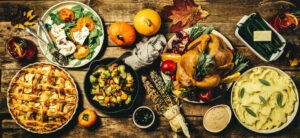
The Thanksgiving spread has evolved over the years (Credit: Alamy)
But do you ever wonder where Thanksgiving’s food traditions come from? It goes without saying that marshmallow topped casserole wasn’t on offer in 1621, and the pilgrims probably wouldn’t have eaten roasted turkey, either.
As Thanksgiving returns for another year, we explore the origins of some of the most popular Thanksgiving food, and how each dish became a mainstay on our tables today.
Thanksgiving Turkey
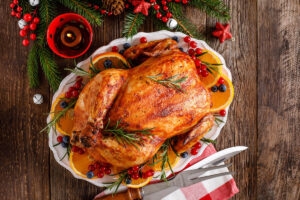
The Thanksgiving turkey is an undisputed staple (Credit: Alamy)
Turkey is perhaps one of the oldest Thanksgiving traditions, harking back to before the holiday was officially declared by Lincoln.
Reflecting on early celebrations, Alexander Hamilton is believed to have said: “No citizen of the U.S. shall refrain from turkey on Thanksgiving Day.” But why do we eat turkey on Thanksgiving, and how did the bird become such a holiday staple?
“Turkeys are indigenous to the Americas, and were actually first from Mexico,” says American culinary historian and author, Adrian Miller. “They were domesticated by the Aztecs, but by the time the European colonists show up, you’ve got turkeys all the way from Central America to eastern Canada, and they were wild birds that roamed freely.”
Despite their abundance around the time of the pilgrims’ supposed ‘feast’, Miller says “there’s no explicit mention of turkeys on the first Thanksgiving, and though they may well have been there, what you hear about are venison and fowl.”
Instead, he thinks the turkey’s inclusion in the traditional Thanksgiving dinner is something that occurred later, as a result of European food traditions carrying over to the States.
“I think of turkey as replacing the roasted goose of Europe, because if you look at old menus, you’ll see that was eaten on Christmas and other significant days,” Miller explains.
Many other food historians also cite the sheer availability of the bird as a key reason it was used instead of other fowls, and became a tradition across America.
Thanksgiving Cranberry Sauce
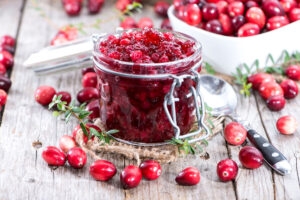
Cranberry sauce also has an interesting backstory (Credit: Alamy)
You rarely find a Thanksgiving turkey without a dollop of cranberry sauce these days, and this tradition is born out of a mixture of indigenous ingredients and so-called ‘New World’ techniques.
“Cranberries were indigenous to America, and people would have eaten them, but certainly not in the way the Europeans did,” Miller explains. “Europeans had them with sugar, and the preparation was very similar to the English barbary conserve, so cranberry sauce today is likely an adaptation of an old British dish, but with [indigenous] ingredients.”
Whilst cranberry sauce as we know it today wouldn’t have been around at the time of the orginal Thanksgiving meal, about 50 years later the condiment would have been much more common as a result of colonisation.
In fact, a 1672 account (cited by The Washington Post) stated that the “Indians and English use it much, boyling [cranberries] with sugar for a sauce to eat with their meat (sic).”
Then, in 1796, Amelia Simmons, who wrote American Cookery – America’s first cookbook – suggested serving the sauce with turkey, specifically. She also suggested pickled mangoes as an alternative, but due to the larger supply of cranberries, the former ended up sticking.
Thanksgiving cranberry sauce became mainstream after Marcus L Urann, the founder of Ocean Spray, created it in ‘jellied’ form in 1912, so that the ingredient could be kept fresh, and easily acquired over the holidays.
In fact, it’s hard to imagine a cranberry-less Thanksgiving meal these days.
Thanksgiving Collard Greens and Green Bean Casserole
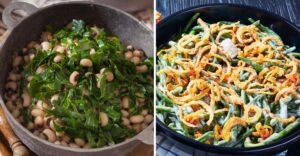
Collards and green bean casserole are common Thanksgiving sides (Credit: Alamy)
There are two types of greens commonly eaten over Thanksgiving: collard greens and green bean casserole.
The green bean casserole is a relatively new addition to the Thanksgiving table. Many historians say it came about for two reasons – convenience (it was known as the ‘jiffy casserole’, because it was so easy), and the tradition of eating green foods around Christmas, which was taught in cookbooks and cooking schools throughout the 20th century.
“Casseroles bound with white sauces became especially prevalent during the Depression as a way of stretching ingredients,” explains Cathy Kaufman, president of the Culinary Historians of New York.
The green bean casserole as we know it today then came along thanks to a very smart call from the folks at Campbells, who put a recipe for the dish on their tins of mushroom soup in 1955, and suggested incorporating the soup for creaminess.
“Luxurious versions [of casseroles] are colonial, but it does seem that the convenience of frozen green beans brought this recipe to the forefront in that age of convenience cookery,” Kaufman adds of the Thanksgiving side dish.
Even today, Campbells believes that 30 percent of the cream of mushroom soup cans sold in America are used to make the casserole over the holidays. Now that’s successful marketing…
As for Thanksgiving collard greens? They’re typically enjoyed in the American south, where Miller cites “two similar traditions coming together and clashing” – the area’s “pronounced African presence” and the British pottage tradition which arrived during colonisation.
“The south [housed] enslaved Africans who came from food traditions where greens were a very central part of their diet,” he says. West African bitter leaf was traditionally eaten with a mix of meats, but when enslaved, “they substituted in greens of Europe [collards, kale, cabbage, mustard and turnip] which were being cultivated in the Americas from as early as the 1600s,” Miller explains.
Collards were also some of the only vegetables enslaved Africans were allowed to grow themselves, according to the Collard Green Museum in Charlotte, North Carolina.
Though it’s hard to pinpoint an exact date this dish joined southern American Thanksgiving tables, Miller predicts that they would have started to feature during early celebrations around the 17th century, when enslaved Africans were primary cooks on a lot of plantations.
Given the amount of African-American people living in the south, it’s only natural, then, that this remains a foodway, and such an typical Thanksgiving meal component on southern tables today.
Thanksgiving Sweet Potato Casserole and Candied Yams

Do you like marshmallows on your casserole? (Credit: Alamy)
Sweet potatoes also feature heavily on the traditional Thanksgiving menu, and have done since early celebrations, thanks to their availability throughout America.
“What’s interesting is that some people thought that sweet potatoes were from Europe or Africa, when they really were from the Americas,” Miller explains. “They’re native to South America, but Spanish explorers saw them, took them back to Europe and then Europeans fell in love with them.
“It was only then they got brought over to the more northern parts of the Americas [during colonisation], and became more widespread.”
In terms of Thanksgiving, they were first enjoyed as candied yams (which are exactly the same as sweet potatoes, but used interchangeably in the States). Miller says this dish, and the sweet potato casserole that followed, were inspired by the common use of root vegetables like carrots in desserts throughout British cookery.
“There are some that would argue that candied yams could be an adaptation of Fufu which is an African dish made of pounded yam,” says Miller. “But this tends to be a savoury thing, and so the addition of butter, sugar and spices leads me more to believe this was inspired by how Europeans were cooking.”
Whilst different chefs had their own methods, the history points to the fact that adding a sweet syrup to root vegetables is a French technique which you would have seen in the 1800s.
As for the marshmallows you often see on top of Thanksgiving sweet potato casseroles today? Like green bean casserole, this came around for rather more corporate reasons.
Campfire brand, Angelus Company, featured the first recipe for sweet potato topped with marshmallows in 1917, “to encourage home cooks to embrace the candy as an everyday ingredient.”
And what do you know? It all took off from there, and the sweet potato and marshmallow dish went on to become a popular side dish throughout the US, combining the new sweet treats (first invented by the French in the 1800s) with the popular American vegetable.
Today, marshmallow topped sweet potato casserole is still enjoyed by some families on Thanksgiving, though it is (and probably always will be) a crowd divider.
Some people stick to candied yams instead (and, honestly, we don’t blame them).
Thanksgiving Pumpkin Pie and Sweet Potato Pie
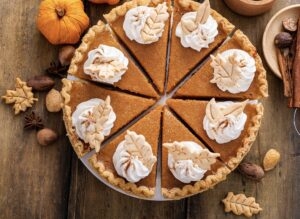
Thanksgiving pumpkin pie is another favourite (Credit: Alamy)
Why do we eat pumpkin pie on Thanksgiving, you might wonder?
Not dissimilar to casseroles, Thanksgiving pumpkin pies and sweet potato pies also mix Native American ingredients with the European culinary traditions, in particular the English tradition of pie making.
“Like sweet potatoes, pumpkins are indigenous to the Americas,” says Millar. “They were introduced into Europe prior to colonisation, so Europeans were familiar with them, and we see the earliest pumpkin pies in British cooking in the 1600s – although, they’re not what we talk about today.
“In early pumpkin pies, the pumpkin was sliced and then stewed or fried and topped with a crust, or they’d take pumpkins and hollow them out, and then fill them with apples and all sorts [of spices].
“The pies we have today are custard pumpkin pies, which are an American innovation which came about later.”
It’s Amelia Simmonds’ 1769 book we have to thank here, once again, as it made reference to the first pumpkin pie as we know it on Thanksgiving tables (with the addition of a top crust which today is removed).
This was likely inspired by the likes of a custard carrot pie which was cooked in Britain.
“You can see somebody saying, ‘oh, let me take this other orange sweet thing and swap out the carrots and I’ll just substitute that in,’” Miller says.
Interestingly, the historian adds that whilst pumpkin pie is a popular Thanksgiving dish amongst many Americans today, sweet potato pie is more commonly enjoyed in Black communities, because “African-Americans descended from people that were used to having root vegetables like tropical yams, and so swapped sweet potatoes into their cookery.
“There’s certainly pumpkins available in the south, but I think it’s that cultural connection to root crops that led to the popularity of sweet potato pie in Black communities,” he adds. “Even though they look the same, and many people say they taste similar”.
Both root vegetable pies began to appear on Thanksgiving tables gradually in the years following Simmonds’ book, and by 1869 the Hartford Connecticut Courant stated that the pie was an “inevitable” part of the traditional Thanksgiving dinner.
Thanksgiving Mac ‘n’ Cheese
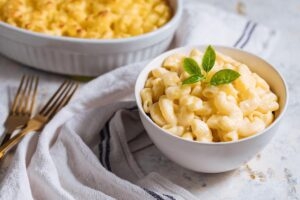
Mac and Cheese is a beloved celebration food in the US (Credit: Alamy)
Some people might dispute that mac ‘n’ cheese is a Thanksgiving side dish, but it is so linked to southern American soul food and celebration food, that it would be remiss not to include it.
It arrived in America after Thomas Jefferson visited Europe in the 1780s and loved the ancient dish so much that he instructed his chef, James Hemings, to learn how to recreate it in America.
Hemings is said to have accompanied Jefferson on a trip to France, where he was tasked with training in French cookery and adapting the recipe. He then taught it to his brother, Peter (also enslaved by Jefferson), who served it at a White House dinner.
Thanks to Hemings, and no doubt other enslaved Africans forced to learn the dish by their wealthy American owners, mac ‘n’ cheese became popular in the States, and only continued to do so following the emancipation proclamation.
“Enslaved Africans [would not have been initially] familiar with mac ‘n’ cheese because there’s nothing like that in their foodway, but it’s something that they were forced to make, and later embraced fully in the Black community. By the early 1800s, it became a special occasion dish.
“I don’t know when it became a Thanksgiving staple, but it clearly is one now – especially in southern homes and African-American homes,” Miller adds.
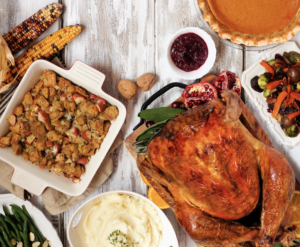
Today, Thanksgiving dinner tells the story of America (Credit: Alamy)
So, there you have it – the origins of nine Thanksgiving favourites.
You may never have realised that your plate tells a story of Thanksgiving history, when you tuck in on the third Thursday of November, every year.
But there’s no denying that knowing how traditions have evolved since the first Thanksgiving meal only further hammers how far America has come, and the importance of the American holiday.



.jpg_dU0O4c?tr=w-2560,f-webp,q-70)